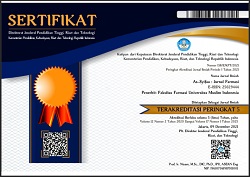PENGUJIAN AKTIVITAS EKSTRAK ETANOL KULIT BUAH KECOMBRANG (Etlingera elatior (Jack) R.M.Sm) SEBAGAI INHIBITOR TIROSINASE
Abstract
Healthy skin should have a flat surface, the texture is soft, elastic, and have the same skin color. Skin color is determined by the size, number and distribution of melanin pigment. Pigment brownish pigment melanin is to protect the skin from UV light scattering. An enzyme that plays a role in this browning reaction is tyrosinase. Based on this research is conducted on the fruit skin kecombrang to see the activity of the enzyme tyrosinase barriers and whether rind kecombrang can inhibit tyrosinase enzyme and with the aim to utilize natural materials and waste that can inhibit the enzyme tyrosinase and can be used as a skin whitheter. Research iniated by the extraction of fruit skins kecombrang using etanol. Flavonid content test on the sample using Mg powder and HCl p, the results show a color change from dark brown to yellow. So positive it contains flavonoids. Measurements were contucted on a maximum wavelength of 478,003 nm, using the substrate L-tyrosine and the enzyme tyrosinase. Using comparators hidroquinon. Of the results of this study concluded that kecombrang fruit peel ectract at a concentration of 2 mg/mL could inhibit amounted to 55,92% and a concentration of 2,5 mg/mL could inhibit amounted to 56,58%
Keywords
Full Text:
PDF (Bahasa Indonesia)References
Paul AJ. Anatomy and Physiology of the Skin Journal of the Dermatology Nurses Association. 2011; 3(4):203-213.
Pandel R, Poljsak B, Godic A, Dahmane R. Skin Photoaging and The Role of Antioxidants in Its Prevention. International Scholarly Research Notices (ISRN Dermatology). 2013; Article ID 930164.
Ichihashi M, Ando H, Yoshida M, Niki Y, Matsui M. Photoaging of the Skin.Journal of Anti Aging Medicine. 2009;6(6):46-59.
Hartanti L, Setiawan HK. Inhibitory Potential Of Some Synthetic Cinnamic Acid Derivatives Towards Tyrosinase Enzyme. Indo. J. Chem. 2009;9(1):158-168.
You J, Jae KN, Ji HL, Hae YC. 4,4-Dihidroxybiphenyl as a New Potent Tyrosinase Inhibitor. Biological and Pharmaceutical Bulletin. 2005;28(2):323-327.
Nerya O, Musa R, Khatib S, Tamir S, Vaya J. Chalcones as potent tyrosinase inhibitors: the effect ofhydroxyl positions and numbers. Phytochemistry. 2004;65: 1389-1395.
Chang TS, Ding HY, Lin HC. Identifying 6,7,4’-Trihydroxyisoflavone as a potent Tyrosinase Inhibitor. Biosci. Biotechnol. Biochem. 2005;69(10): 1999-2001.
Rohaeti E, Batubara I, Lieke LDNA, Darusman LK. Potensi Ekstrak Rhizophora sp sebagai Inhibitor Tirosinase. Bogor: Prosiding Seminar Nasional Sains III (Biochemistry). 2010;196-201.
Adhami VM, Afaq F, Ahmad N. Suppression of Ultraviolet B Exposure-mediated Activation of NF-kappaB in Normal Human Keratinocyte by Resveratol. Neoplasia. 2003;5(1):74-82.
Chang TS. An Updated Review of Tyrosinase Inhibitors. Taiwan: Department of Biological Science and Technology.National University Tainan, 2009.
Baumann L, Alleman IB. Depigmentation Agent. In Baumann L, Saghari S, Weisberg E, editors. Cosmetic Dermatology.2nd edition. New York: McGraw Hill. 2009. p 280-288.
Stallings AF, Lupo MP. Practical uses of botanicals in skin care. J Clin Aesthet Dermatol. 2009;2(1):36-40.
Pinnel SR. CutaneusPhotodamage, Oxidative Stress, ,and Topical Antioxidant Protection. Journal of the American Academy of Dermatology. 2003;48:1-22.
Tampubolon OT, Suhatsyah S, and Sastraprajda S. Penelitian pendahuluan kimia kecombrang (Nicolaia speciosa Horan). Yogyakarta: Risalah Simposium Penelitian Tumbuhan Obat III. Fakultas Farmasi UGM yogyakarta, 1983.
Naufalin R. Kajian Sifat Antimikroba Ekstrak Bunga kecombrang (Nicolia speciosa Horan) Terhadap Berbagai Mikroba Patogen dan Perusak Pangan (Disertasi). Bogor: Sekolah Pascasarjana. Institut Pertanian Bogor, 2005.
Antoro ED. Skrining Fitokimia Rimpang Nicolia speciosa Horan Secara Mikrokimiawi Kromatografi Lapis Tipis dan Spektrofotometri UV. Jogjakarta: FF-UGM, 1995.
Krismawati A. Uji Toksisitas Beberapa Jenis Tanaman Indonesia Yang Dipercaya Dapat Menurunkan Berat Badan(Ceremai, Jati Belanda, KunciPepet, Delima Putih, Bangle,Kemuning) Terhadap ProliferasiSel limfosit Manusia Secara InVitro (Skripsi). Bogor: IPB, 2007.
Asmah R and Yan SW. Comparison of Total Phenolic Contents and Antioxidant activities of Turmeric Leaf, Pandan Leaf, and Torch Ginger Flower. International Food Research Journal. 2010. 17: 417-423
Naufalin, Rifda and Rukmini HS. Potensi Antioksidan Hasil Ekstraksi Tanaman kecombrang (Nicolaia speciosa, Horan) Selama Penyimpanan. Purwokerto: Fakultas Pertanian. Universitas Jenderal Sudirman. 2011.
Naufalin R and Rukmini HS. International Conferenceon Nutrition and Food Sciences. Singapore: IPCBEE. IACSIT Press, 2014.
Handayani V, Ahmad AR, Sudir M. Uji Aktivitas Ekstrak Metanol Bunga dan Daun Patikala (Etlingera elatior (Jack)R.M.Sm) Menggunakan Metode DPPH. Pharm Sci. 2014;1(2):86-93.
Markham KR. Cara Mengidentifikasi Flavonoid, diterjemahkan oleh Kosasih Padmawinata. Bandung: Penerbit ITB, 1988.
Ozer O, Mutlu B, Kivcak B. Antityrosinase Activity of Some Plant Extracts and Formulations containing Ellagic Acid. Pharmaceutical Biology. 2007;45(6):519-524.
Ditjen POM. Farmakope Indonesia. Ed III. Jakarta: Departemen Kesehatan RI, 1979.
Kim YJ, Kyung KJ, Lee JJH, and Chung HY. 4-4-Dihydrroxybiphenyl as a New potent Tyrosinase Inhibitor. J. Biol. Pharm. Bull. 2004;28(2):323-327.
Ramsden CS and Patrick AR. Mechanistic Studies of Tyrosinase Suicide Inactivation. Special Issue Reviews and Accounts. 2010: 260-274.
DOI: https://doi.org/10.56711/jifa.v13i1.769
Refbacks
- There are currently no refbacks.
Indexed by:
ISSN: 2085-4714 | e-ISSN: 2502-9444
Editor's Address:
Faculty of Pharmacy, Univeristas Muslim Indonesia
2nd Campus of UMI: Jl. Urip Sumoharjo km. 5 , Makassar, South Sulawesi, Indonesia
E-mail: jurnal.farmasi@umi.ac.id















